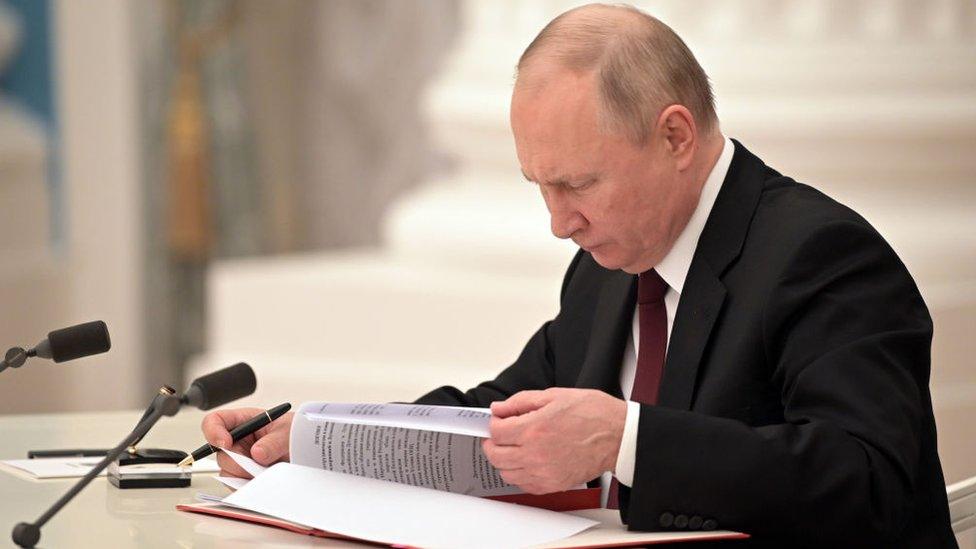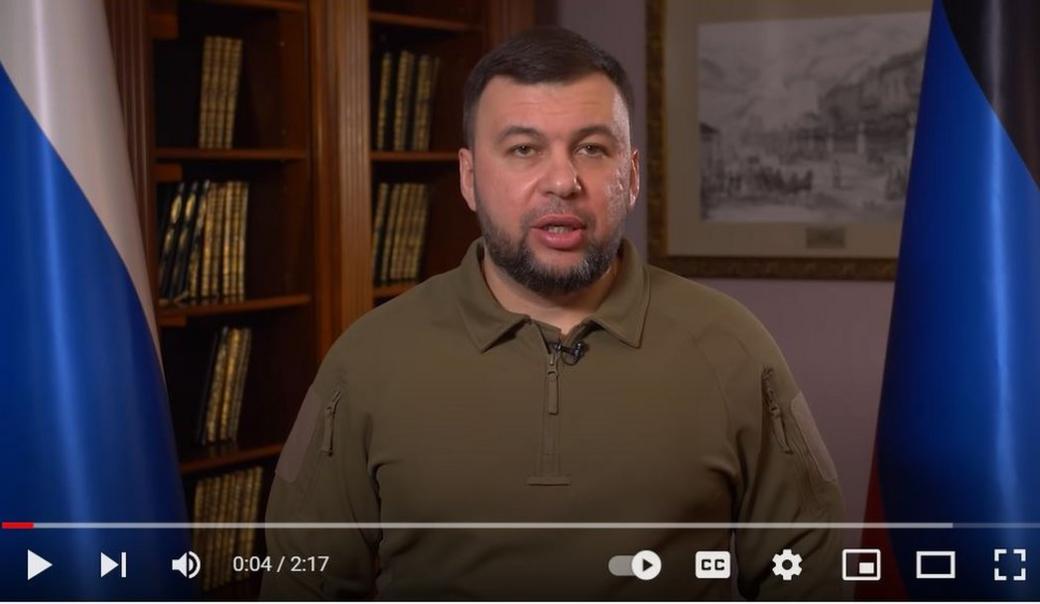Ukraine crisis: Is Russia staging 'false flag' incidents?
- Published

Russian authorities have cited a number of incidents in eastern Ukraine in order to justify military action.
In his speech on Monday, Vladimir Putin said that the Ukrainian authorities "are not interested in a peaceful solution."
"On the contrary, they are trying to set up a blitzkrieg in Donbas," he said.
But the US has warned of Russia faking provocative acts - so-called "false flag" incidents which are staged to appear to come from one side in a conflict - in order to create a pretext for action.
So what has happened in eastern Ukraine and what do we know about it?
Alleged 'sabotage' of separatists
The Organisation for Security and Cooperation in Europe has tracked thousands of ceasefire violations, external in recent days.
But there is a growing body of evidence indicating that online rumours have misrepresented some attacks, and that some events may have even been staged.
For example, on Friday, a video circulated, external on a Telegram channel run by Russia-backed separatists. It claimed to show a clash between an "enemy sabotage group" and pro-Russian forces in eastern Ukraine.
The post said the video showed pro-Ukrainian militants trying to blow up a chlorine tank in the separatist-held area of Donbas.
"The armed formations of Ukraine are purposefully trying to sow fear and panic among the civilian population," the post claimed. "The above facts are direct confirmation of the preparations of the Ukrainian side to unleash hostilities."
The video was then picked up by pro-separatist and Russian news agencies.
But open source investigators on social media, external pointed out several discrepancies which indicated the video was shot at an earlier date and had been manipulated.
When inspecting the video's metadata - which can be used to see when a file was created or modified - investigators discovered it had a creation date of 8 February - ten days before it was posted.
The video also appears to have audio dubbed over it taken from a YouTube clip posted in 2010 of a military firing range in Finland. It looks highly unlikely that this video shows what the separatists claim it shows.
Donetsk evacuation
Other stories have created an impression of impending panic in the separatist areas.
Also on Friday, leaders of the two separatist areas called for a mass evacuation of residents, saying Ukraine had intensified hostilities and was planning further attacks.

Denis Pushilin announced an 'emergency' evacuation of residents
Denis Pushilin, head of the self-proclaimed Donetsk People's Republic, published a video announcing the "emergency" evacuation.
At one point in the video Mr Pushilin says "today, on 18 February". But a BBC analysis of the metadata showed that rather being recorded in the heat of the moment, this video was also filmed in advance - two days earlier.
'Car bombing' in Donetsk
Russian state media also reported a "powerful explosion", external in the centre of the city of Donetsk, near the separatist government headquarters.
Pro-Russian separatists alleged it was a car bombing and Denis Sinenkov, chief of the Donetsk separatist police, claimed the vehicle belonged to him, external. Russian media reported that nobody was hurt in the incident.
But questions have been raised about whether the attack was staged.
Russian journalist Anton Pustovalov tweeted, external that the number plate on the destroyed car was taken from a different vehicle, external - one the head of the separatist police was previously spotted using - in order to then say that a "terrorist attack was being launched against him".
Allow X content?
This article contains content provided by X. We ask for your permission before anything is loaded, as they may be using cookies and other technologies. You may want to read X’s cookie policy, external and privacy policy, external before accepting. To view this content choose ‘accept and continue’.
The BBC is unable to independently verify these claims. The Ukrainian government has denied several of the online rumours.
Allow X content?
This article contains content provided by X. We ask for your permission before anything is loaded, as they may be using cookies and other technologies. You may want to read X’s cookie policy, external and privacy policy, external before accepting. To view this content choose ‘accept and continue’.
'Ukrainian' vehicle
Questions have also been raised about some of the footage shown on Russian state TV as illustration of alleged Ukrainian acts of aggression.
The Russian military claimed on Monday that its forces had killed five members of a Ukrainian "saboteur group" and destroyed two armoured personnel vehicles following an alleged incursion into Russian territory.
Reporting from the site of the alleged clash, Channel One - one of Russia's most popular state TV channels - showed footage, external of what it described as one of the destroyed Ukrainian vehicles.

The rear of the burned BR-70M vehicle broadcast on Russian state TV
But Sam Cranny-Evans, a research analyst at the defence think-tank RUSI, says there is "no compelling evidence to say it's a Ukrainian vehicle".
Both Ukrainians and Russians have produced the BTR-70 vehicles, Mr Cranny-Evans says, and there are different versions of it, but the one shown on Russian TV is similar to the version produced in Russia.
Experts with the Ukrainian military portal Militarnyy also said that the vehicle was the Russian version of BTR-70M, which has been produced at a plant in the Russian city of Arzamas since 2006.
Deadly Donbas car attack 'looks staged'
Footage has emerged from pro-Russian outlets claiming to show a car blown up by a roadside bomb in Donbas. According to one video, inside the charred vehicle are the remains of three dead civilians.
Local news reports and posts on separatist Telegram channels said the intended target was a separatist military commander.
But a retired bomb disposal expert who has reviewed the footage has cast serious doubts on the allegations.
"There is nothing in those images or videos to support the claims," says Pete Norton, a weapons intelligence specialist.
The key is the location of the car - in footage shot at the scene, there's no evidence that a bomb had been buried in the road or that the vehicle was travelling at speed when it was destroyed.
If, as claimed, the car was destroyed by a roadside device, it's much more likely that the car would have carried on moving instead of appearing to stop next to the site of the explosion.
Mr Norton also says graphic up-close images of the bodies inside the cars that surfaced in a YouTube video further undermine the allegations.
One of the skulls shows, he says, "clear indication of having undergone a post-mortem cranial autopsy" - it's impossible that such a procedure would happen at the scene of an attack. The suggestion, he says, is that cadavers were used in a staged incident.
